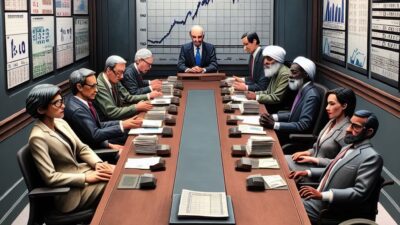US Inflation Surpasses Expectations, Increasing Living Costs
In a concerning development for American households, inflation rates exceeded forecasts in the previous month, resulting in a significant rise in living expenses. The latest figures prompt questions about the economy’s resilience and the future of purchasing power for consumers.
An Unwelcome Surprise in Inflation Data
Recent reports from the Bureau of Labor Statistics revealed that the Consumer Price Index (CPI) climbed higher than anticipated, indicating that the rate of inflation in the United States remains stubbornly persistent. Analysts had predicted a more modest increase in prices; however, the reality was starkly different. This unexpected surge in inflation continues to raise alarms and is raising new challenges for everyday Americans trying to manage their budgets.
Inflation, measured by the CPI, increased by 0.6% in the previous month, outpacing the 0.4% expected by economists. Year-over-year, inflation now stands at 3.7%, a marked increase that has prompted discussions across various sectors regarding its implications.
Impact on Everyday Americans
The rise in inflation has immediate effects on the average American consumer, as essential costs such as food, gas, and housing make up a substantial portion of household budgets. For families already grappling with the lingering effects of the pandemic, this uptick in prices exacerbates financial pressures.
Grocery prices, in particular, have seen a significant uptick, with several staple items becoming noticeably more expensive. According to industry insiders, prices for meat, dairy, and fresh produce have surged, placing greater strain on family budgets. Alongside escalating utility costs and rent, many households are feeling the pinch.
“Hiking gas prices also add fuel to the fire. As commuting costs rise, so does the pressure on working families,” noted Kelly Thompson, a financial advisor in New York City. “People are having to make tough decisions about their spending habits just to keep up with inflation.”
The Broader Economic Context
This recent inflation spike is not occurring in a vacuum. The economy is navigating a complicated landscape influenced by various factors, including supply chain disruptions post-COVID-19, labor shortages, and shifts in consumer demand. While the Federal Reserve has taken measures to combat inflation through interest rate hikes, the results of these policies have not yet yielded the desired cooling effect on price growth.
In response to inflation pressures, the Federal Reserve has signaled its intent to maintain vigilance regarding further interest rate adjustments. “We are committed to ensuring that inflation moves back towards our target of 2%,” said Federal Reserve Chair Jerome Powell in a recent statement. Nevertheless, the effectiveness of these strategies remains uncertain, with many economists anticipating that inflation may continue to fluctuate in the coming months.
Consumer Sentiment on the Rise
In the face of climbing inflation, consumer sentiment has seen a dip. Surveys indicate that many shoppers are increasingly concerned about the state of the economy. A recent Gallup poll found that nearly 60% of Americans consider inflation to be the most pressing issue currently facing the nation.
As confidence wanes, spending habits are beginning to change. Many consumers are opting for cheaper brands, cutting back on discretionary spending, or delaying major purchases like cars and homes due to uncertainty surrounding future costs. This shift in behavior may have a ripple effect on the economy’s recovery trajectory.
Sector-Specific Effects
Different sectors of the economy are reacting to the inflationary pressures in various ways. The housing market, for instance, is particularly sensitive to interest rate changes. Rising mortgage rates, driven in part by inflation-fighting measures, could deter potential homebuyers, impacting housing demand and prices.
Conversely, certain industries may find opportunities amid these challenges. For instance, businesses in value retail or discount chains may see an influx of customers seeking more affordable alternatives. Similarly, industries that focus on efficiency and minimalism may flourish as consumers prioritize value over luxury.
Looking Ahead: Experts Weigh In
As inflation rates remain uncertain, experts emphasize the importance of vigilance and adaptability. “Inflation is not just a number; it’s a reality for families who are trying to make ends meet,” stated economist Dr. Sarah Lewis. “It is crucial for policymakers to respond thoughtfully to these ongoing challenges.”
The road ahead may be bumpy, but understanding the nuances of inflation’s impact on daily life can offer consumers the insight needed to navigate these difficult times. While some signs suggest inflation may begin to ease, the journey towards economic stability is bound to be complex and multifaceted.
Conclusion
The recent spike in US inflation serves as a stark reminder of the economic difficulties facing many American households today. With rising costs impacting everyday life and consumer confidence waning, the need for sound economic policy and a deep understanding of consumer behavior has never been more vital. As families adjust to these changing circumstances, all eyes will be on how the economy responds in the months to come.











